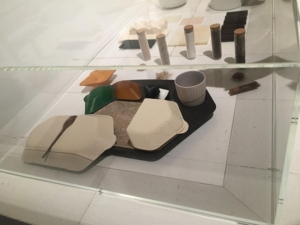Centre for Design and the Waste Age: A trip to the Design Museum
12/04/2022

In December of 2021, the C4D Design Thinking team made their way to London, Kensington Park for an educational (but fun-filled and not to mention – covid-safe) trip to the Design Museum. It was essential to see in-person how designers integrate sustainable strategies and tools into their product development.
The week prior to the trip was intense. Guest speakers such as Ken Webster (International Society for Circular Economy), Joāo Murilo (Ellen McArthur Foundation), Ian Mckenzie (Trojan Energy Ltd), introduced not only the environmental applications but social and economic impacts that Circular Economy and the Cradle-to-Cradle standard can generate. It was safe to say we gained a lot of theoretical knowledge about whole system designs and all processes that are born from these theories. But does the theory actually translate to practice? Is there any impact on our everyday life?
Fast forward to a week later –

The Design Museum introduced newfound sustainable products that had the potential to seamlessly glide into consumers’ lives.
Take aeroplane meal trays for instance. A hot main meal dish and lid is made of bamboo, a spork made of coconut wood and can be reused several times before it needs to be composted, a cover lid consisting of banana leaf and the base of wheat bran, a waffle-cone dessert dish and lid that is edible, the cup liner made of algae (biodegradable), and the tray is made of coffee grains mixed with lignin binder. Each material and process all reduce waste or eliminate waste from the design. As we walked around, we were inspired to think about our own roles as students, consumers and designers to encourage organisations to take a longer-term integrated view of their products and services. This is part of our responsibility to be able to influence certain decision making for policies like product life cycles or material selection.
it needs to be composted, a cover lid consisting of banana leaf and the base of wheat bran, a waffle-cone dessert dish and lid that is edible, the cup liner made of algae (biodegradable), and the tray is made of coffee grains mixed with lignin binder. Each material and process all reduce waste or eliminate waste from the design. As we walked around, we were inspired to think about our own roles as students, consumers and designers to encourage organisations to take a longer-term integrated view of their products and services. This is part of our responsibility to be able to influence certain decision making for policies like product life cycles or material selection.
The exhibition was called Waste Age: What can design do? and featured various winding rooms allowing audiences to explore products that we as consumers utilise in everyday life – from fashion, food, electronics, construction and packaging. The focus lies on waste – specifically “solid waste that is disposed of in landfill or through incineration” after the consumption or exhaustion of its purpose. The Waste Age reconsiders its re-usage to transform waste into resources again – closing the loop. Others may view re-usage as ‘one man’s trash is another man’s treasure.’
 Seeing these objects out of the context of the home, isolated in its glass containers, and propped up on plinths sparked a certain tension that made us reconsider many options when it comes to their purpose and repurposes. We began to question whether there were alternative ways to fulfil the purpose this product was intended for; is it outdated?
Seeing these objects out of the context of the home, isolated in its glass containers, and propped up on plinths sparked a certain tension that made us reconsider many options when it comes to their purpose and repurposes. We began to question whether there were alternative ways to fulfil the purpose this product was intended for; is it outdated?
Since most items were exhibited, we seemed to pay more attention to aesthetics such as shape, form and purpose but there was another more crucial dimension to consider. Its materials and environmental, social and economic effects upon the end of the product’s life cycle. For us consumers, it is unlikely we would think about its wider impact after we have binned a plastic cup.
A noticeable video installation (several old working TV monitors supported by wooden shelves) was presented by Ibrahim Mahama who used electronic waste using plugs, cords and other electronic components as his main materials. While for some, viewing these products was sentimental and familiar ‘back in my day…’, it was astounding to see that some of the televisions could still function as such since these products have come and been long gone, never to return to the homes of consumers.
homes of consumers.
Sadly, the reality of where these components were founded is more shocking. For instance, Accra, Agbogbloshie is the largest e-waste dump in the world and used by other countries to dump electronics. E-waste is incinerated or broken down by local workers to access metals inside – a dangerous process that leads to injury and illness.
Fortunately, change begins with a good design. Visionary designers are reinventing the relationship with waste – Formafantasma, Stella McCartney, The Ellen MacArthur Foundation, Lacaton & Vassal, Fernando Laposse, Bethany Williams, Phoebe English and Natsai Audrey Chieza. These works are encouraging to us as students to realise that change can only come with collaborations to do better not less bad.
At the end of the insightful journey, a fellow coursemate and I were feeling quite parched. We reached the gift shop after exiting the exhibition and saw a vending machine with several small pouches of fruit juice packaged in edible plastic made of seaweed. While it may have literally felt like eating a plastic pouch, it was a new and exciting experience to find that the packaging was degradable whether it was tossed on the ground or broken down by our stomachs. It did make us think about how this could be introduced as a specific need for quick on-the-go thirst relief, especially if it were a juice that could provide a sugary energy boost. For instance, marathon runners could benefit from this product as they can be given this drink during their milestones. Overall, 10/10 for taste and sustainability!
Categories & Tags:
Leave a comment on this post:
You might also like…
Keren Tuv: My Cranfield experience studying Renewable Energy
Hello, my name is Keren, I am from London, UK, and I am studying Renewable Energy MSc. My journey to discovering Cranfield University began when I first decided to return to academia to pursue ...
3D Metal Manufacturing in space: A look into the future
David Rico Sierra, Research Fellow in Additive Manufacturing, was recently involved in an exciting project to manufacture parts using 3D printers in space. Here he reflects on his time working with Airbus in Toulouse… ...
A Legacy of Courage: From India to Britain, Three Generations Find Their Home
My story begins with my grandfather, who plucked up the courage to travel aboard at the age of 22 and start a new life in the UK. I don’t think he would have thought that ...
Cranfield to JLR: mastering mechatronics for a dream career
My name is Jerin Tom, and in 2023 I graduated from Cranfield with an MSc in Automotive Mechatronics. Originally from India, I've always been fascinated by the world of automobiles. Why Cranfield and the ...
Bringing the vision of advanced air mobility closer to reality
Experts at Cranfield University led by Professor Antonios Tsourdos, Head of the Autonomous and Cyber-Physical Systems Centre, are part of the Air Mobility Ecosystem Consortium (AMEC), which aims to demonstrate the commercial and operational ...
Using grey literature in your research: A short guide
As you research and write your thesis, you might come across, or be looking for, ‘grey literature’. This is quite simply material that is either unpublished, or published but not in a commercial form. Types ...






